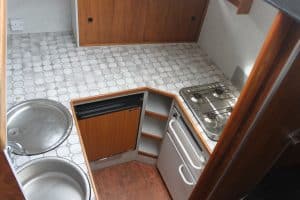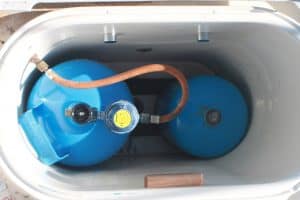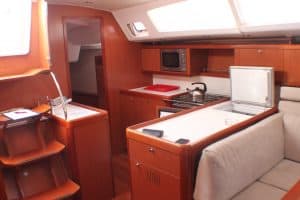Marine Notice No 37 of 2017
Use of liquefied petroleum gas (LPG) installations and systems on merchant vessels, fishing vessels, pleasure craft and other marine craft.
Marine Notice 37 of 2017 LPG installations
The Department of Transport, Tourism and Sport have produced a new notice in relation to the safe use of LPG on vessels. I strongly recommend you read through this notice and make yourself familure with the content.
This Marine Notice supersedes Marine Notice No. 1 of 2002. In response to Marine Casualty Investigation Board recommendations, this Marine Notice replaces, restates and updates the content of Marine Notice No. 1 of 2002 regarding the use of LPG installations and systems on vessels.
Preamble
Whilst the Department of Transport, Tourism and Sport recognises that when handled and used correctly, LPG is a cost effective and versatile fuel for use on marine craft, it urges vessel owners, operators, masters and skippers to consider the use of other fuels such as electricity or gas oil for end appliances.
Dangers and Best Practice Guidance
Due to the continuing use of LPG systems on smaller cargo ships, fishing vessels, pleasure craft and other marine craft, the Irish Maritime Administration of the Department of Transport, Tourism and Sport wishes to draw attention to the dangers which may accompany the use of such systems, and to provide advice and guidance on the fitting and use of LPG installations and systems.
When handled incorrectly, the dangers associated with LPG systems include fire, explosion, burns and asphyxiation due to gas leakage from the system or accumulation of gas following flame failure in an appliance. Such incidents have caused loss of life and material damage.
Installation and Testing:
To help prevent accidents with LPG systems, such systems should be installed at least in accordance with the International Standard ISO 10239:2014 (Small craft – Liquefied petroleum gas (LPG) systems) and with the Appendix to this Marine Notice, which includes the main points of ISO 10239:2014.
The Department of Transport, Tourism and Sport wishes to stress the importance of obtaining expert advice regarding the installation of LPG systems. It recommends that an inspection and test of such systems and associated alarm systems be carried out at least monthly to ensure their correct operation.
Use of liquefied petroleum gas (LPG) installations and systems on merchant vessels, fishing vessels, pleasure craft and other marine craft.
Ventilation:
As with any open flame type appliance, there is risk of asphyxiation due to oxygen depletion of the atmosphere and carbon monoxide poisoning where an open flame LPG appliance is operated in an area with inadequate ventilation, or where combustion is incomplete.
It is dangerous to sleep in spaces where open flame type appliances are operated. Heaters without flues should not be sited in sleeping quarters, adjoining spaces or in any unventilated spaces.
Marking and Storage:
LPG is supplied in pressurised cylinders and is usually propane, butane or a mixture of the two gases. Cylinders must be clearly marked with their contents. LPG has a stenching agent added to enable the presence of gas to be detected by smell, even when its concentration in air is below its lower explosive limit. Butane systems operate at final pressure of 28 mbar and propane systems at 37 mbar. Appliances should be checked to verify which gas they consume. Natural gas appliances are not suitable for use with LPG.
Propane cylinders should be stored outside in a cylinder housing, whilst butane cylinders may be located in a cylinder housing or a cylinder locker. All cylinders must be stored and used upright. LPG systems draw off the vapour phase of the gas from the top of the cylinder whilst the liquid phase remains in the bottom of the cylinder.
LPG is heavier than air and any leakage will tend to fall to the bottom of a compartment. Gas may travel some distance like this and may form an explosive mixture with the air in the compartment. A spark as small as the static discharge from clothing may ignite such a mixture.
Gas detection and alarm system:
In conjunction with any LPG system, the provision of an automatic gas detection and alarm system of a reliable type is strongly recommended and is required when a LPG appliance is installed in spaces below decks. It is essential that any electrical equipment associated with the gas detection alarm and shutoff system is not a potential source of ignition and is ignition protected in accordance with ISO 8846.
Any enquiries concerning this Marine Notice should be addressed to:
Marine Survey Office, Irish Maritime Administration
Department of Transport, Tourism and Sport
Leeson Lane Dublin, D02 TR60
Phone: +353 (0)1 678 3400
Email: mso@dttas.ie
Irish Maritime Administration
Department of Transport, Tourism and Sport
Leeson Lane, Dublin, D02 TR60, Ireland.
23 August 2017
Appendix to Marine Notice No. 37 of 2017
LPG Gas Systems – Main Points
Stowage of gas cylinders
Gas cylinders must be stowed in a cylinder housing or a cylinder locker such that any gas leakage may disperse rapidly.
Cylinders must be restrained against movement and stored upright. On multiple cylinder systems, a non-return valve is to be placed in the supply line near the top of each cylinder. If a change over device is used, it must be provided with non-return valves to isolate any empty cylinders. Where more than one cylinder can supply a system, it shall not be put into use with a cylinder removed. Containers not in use, whether empty or full, shall have the protective cap in place over the cylinder valve. Cylinders shall never be lifted by the cylinder valve.
Safety Devices
Each LPG system shall be provided with a pressure reduction system, located within the cylinder housing or locker, designed to provide a fixed working pressure suitable for the consuming appliances.
Pressure regulators shall not be capable of external manual adjustment.
LPG systems should have an automatic safety gas cut-off device fitted in the low pressure supply line, located within the cylinder housing or locker, which will shut off the supply of gas in the event of a loss of pressure in the supply line, e.g. should a connecting pipe fracture. This device should be of the manual resetting type .
Each LPG system shall:
have an over pressure device, located within the cylinder housing or locker, to prevent uncontrolled pressure in the low-pressure side;
be fitted with a readily accessible manually operated shut off valve in the supply pressure side, located within the cylinder housing or locker and which may be the cylinder valve.
Each LPG appliance shall have a readily accessible shut-off valve located close to the appliance but it shall not be necessary to reach over the top of an appliance to access the valve. If there is only one appliance in the system and the main shut-off valve at the cylinder is readily accessible from the appliance, the low-pressure side shut-off valve need not be fitted.
All shut-off valves are to be clearly marked to indicate their function and the open and closed positions.
Gas detectors should be provided in each compartment containing a LPG appliance. Gas detectors should be positioned and secured in the lower part of the compartment containing the appliance and be of a type that will be actuated promptly and automatically by the presence of gas concentration in air of not more than 0.5%.
Gas detectors should incorporate an audible and visual alarm. All electrical connections should be ignition protected in accordance with ISO 8846. The alarm unit/indicating panel should be located outside the compartment containing the appliance and the cylinder housing or locker, but be visible and audible from within the vicinity of the appliance. Gas detectors should be arranged to automatically cut off the supply of gas from within the cylinder housing or locker in the event of gas leakage being detected.
Carbon monoxide detectors should be provided in each compartment containing LPG appliances.
Smoke and/or heat detectors should be provided in each compartment containing LPG appliances.
Appliances
All LPG appliances fed from a LPG system shall be designed for use at the same working pressure.
Only appliances designated by the manufacturer for use with LPG in a marine environment shall be installed in the system. All appliances shall be fitted strictly in accordance with the manufacturer’s instructions.
Each LPG appliance shall:
be securely fixed to the craft. Gimballed appliances shall have the supporting structure securely attached to the craft. Gimballed appliances shall not have their free movement obstructed;
have flame supervision devices that shut off the supply off gas to the burner in the event of flame failure;
be clearly marked with the type of fuel gas to be used.
All unattended appliances shall be of the room sealed type, with air intake and flue for outgoing products of combustion terminating outside the craft and with the combustion chamber contained in a totally enclosed shield.
Portable heaters, which contain a LPG cylinder inside the heater cabinet, are not suitable for marine craft and should never be used on board vessels of any type.
Cooking appliances shall have the following notice prominently displayed on or adjacent to the appliance:
‘DANGER – Avoid asphyxiation. Provide ventilation when the stove is in use. Do not use for space heating. Do not cover. Do not use unattended.’
Appliances shall be installed away from flammable materials and having regard to inadvertent contact of persons and materials with hot surfaces.
Stove tops shall have fiddles fitted to prevent cooking utensils from sliding off or across the top. These shall be effective to at least 15o pitch angle and 30o roll angle for single hull sailing craft and 15o angles of pitch and roll for motor craft and multihull sailing craft.
Fittings and pipe work
Pipe lines for LPG systems are, as far as practicable, to be of a single continuous length of solid drawn copper piping or drawn stainless steel piping from the cylinder housing or locker to the appliance or the shut-off valve. Thereafter, the piping is to be a further continuous length of solid drawn copper piping or drawn stainless steel piping to the appliance.
The minimum wall thickness for piping shall be 0.6mm for O.D. (outside diameter) less than or equal to 12mm and 0.9mm for piping greater than 12mm.
Piping shall not be of steel, aluminium, lead, plastic or other materials susceptible to either heat and/or corrosion.
In the case of gimballed appliances, a short length of flexible tubing is acceptable. Hoses assemblies shall be designed to be suitable for LPG and to withstand the stresses and exposure found in the marine environment. Hose assemblies shall have permanently attached end fittings such as swaged sleeve or sleeve and threaded insert.
All connections in a LPG pipeline are to be readily accessible, i.e. capable of being reached quickly and safely for maintenance or effective use under emergency conditions without the use of tools.
Piping should not pass through machinery spaces. Where this is unavoidable, it shall be protected by metallic conduit or trunking.
Fittings for joints to piping shall be metallic, galvanically compatible with the piping and of the following types:
Hard soldered
Cutting ring fittings
Compression fittings of copper alloy with solid or thick walled copper rings on copper piping
Stainless steel rings on stainless steel piping.
Joints shall be made without jointing compound on flared or compression fittings.
Ventilation
Compartments containing a LPG appliance should not have access doors or openings to accommodation spaces or their passageways. Where this is impractical, mechanical exhaust ventilation should be trunked to within 300 mm of the deck or floor adjacent to the appliance and adequate inlet ventilation should be provided.
Mechanical ventilation should be designed and installed to eliminate incendive sparking due to friction or impact of the impeller with the fan casing. Electric motors driving fans should be located outside the space, preferably outside the trunking and clear of the outlet. Motors should be ignition protected in accordance with ISO 8846 where this cannot be achieved. Ventilation outlets should be separate from ventilation provided for cylinder housings and lockers, and located away from any intakes and sources of ignition.
Compartments containing a LPG appliance, which are situated on an open deck with direct access to the open deck and no opening direct to accommodation spaces or their passageways, should also be adequately ventilated, preferably by mechanical means.
In small craft where it is impracticable to provide mechanical ventilation as described above, all compartments containing LPG appliances should have adequate natural ventilation, which will prevent a dangerous accumulation of gas. Notwithstanding the need on some craft to be able to close ventilators against the ingress of water in bad weather, ventilation provided for LPG systems should never be closed. If it is necessary to close ventilation provided for LPG systems, the systems should be turned off and the gas supply isolated.
Natural ventilation provided for LPG systems should provide for the extraction of any gas leakage from the system and for the supply of fresh air. LPG is heavier than air and therefore exhaust trunking should be led from the lowest point in a compartment to the open air. Natural exhaust ventilation may be enhanced by the use of selftrimming cowls or rotary exhauster heads.
Ventilation, mechanical or natural, should not interfere with the flame pattern of a LPG appliance such that it may extinguish the flame or cause incomplete combustion of the gas.
The importance of adequate ventilation for LPG appliances cannot be over emphasised. On no account is a ventilation system to be interfered with to prevent it functioning correctly. To do so may put persons at risk of carbon monoxide poisoning, asphyxiation or explosion. Notices should be posted on or adjacent to ventilators advising officers and crew that they should not be closed or blocked.
Flues
Flue components, including ductwork and terminals, shall be installed in accordance with the manufacturer’s instructions for small craft installations.
Flues shall be routed and sized to ensure complete discharge of the products of combustion outside the craft, including outside any areas which can be enclosed by canopies, and so as not to be obstructed by an accumulation of water. The flue system and air intake duct system shall each be continuous and sealed to be vapour tight, both between the air intake outside the craft and the appliance, and from the appliance to its terminal outside the craft. Dampers (shut-off valves) shall not be installed in flue systems.
Installation and Servicing
Only competent installers using the correct materials, tools and equipment should install LPG systems. On completion, the entire system should be tested and commissioned by a competent person prior to first use.
LPG systems should be installed in accordance with ISO 10239:2014 and this Marine Notice. Many references are made in ISO 10239:2014 to other ISO standards relevant to LPG systems. Installers should familiarise themselves with these standards.
LPG systems should be checked for leakage, general condition and correct operation at least monthly.
Ventilation systems should be checked for leakage, general condition, obstructions and correct operation at least monthly.
LPG leakage alarms, carbon monoxide alarms and smoke detectors should be tested for correct operation at least monthly.
LPG systems should be serviced by a competent person at least annually. The servicing should be such as to ensure that the system maintains compliance with the provisions and advice of this Marine Notice and ISO 10239:2014.
The following installation tightness test (from ISO 10239:2014) should be carried out after installation of a LPG system:
The LPG supply line and fittings shall be tested with air. This test shall be performed after installation of the system and appliance(s) as follows:
a. open every branch of the distribution system from the regulating device connection point to the appliance(s); b. connect the test equipment and pressurize to not less than three times the operating pressure of the pressure regulation device, but not more than 15 kPa; c. allow a period of 5 minutes for pressure equilibrium; d. check that the pressure remains constant for not less than an additional 5 minutes.
If any leakage is indicated by a drop in pressure, check the entire LPG system with a suitable leak detection solution to locate the leak while the system is under the test pressure.
Test solutions shall be non-corrosive and non-toxic.
Caution – ammonia, which is present in some soaps and detergents, attacks brass fittings. Although damage is undetectable at first, brass fittings may crack and leak in a matter of months after contact with ammonia.



Emergency Action
A notice detailing the action to be taken when a gas leak is detected, or a fault with the system is discovered, should be prominently displayed on board the vessel. The notice should include at least the following:
The need to be alert for gas leakage.
The action to be taken in the event of gas leakage being discovered.
The use and location of fire extinguishing equipment on board the vessel.
Any appliance instructions relating to the safe operation of appliances.
The location of shut-off valves.
The need to extinguish all flames, cigarettes and not to operate any electrical or other equipment which may induce a spark.